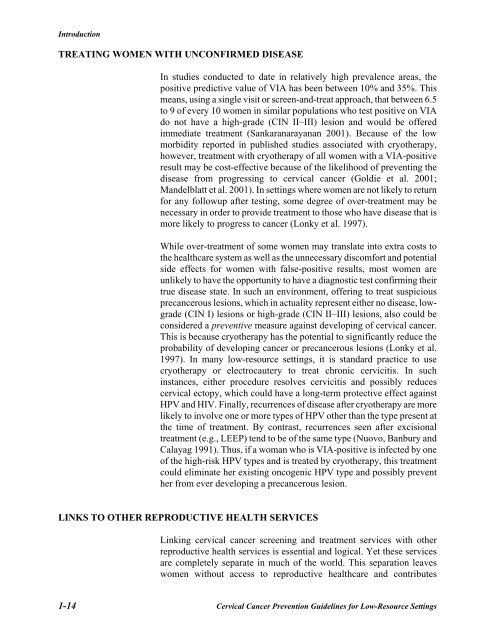Reference Manual - IARC Screening Group
Reference Manual - IARC Screening Group
Reference Manual - IARC Screening Group
You also want an ePaper? Increase the reach of your titles
YUMPU automatically turns print PDFs into web optimized ePapers that Google loves.
IntroductionTREATING WOMEN WITH UNCONFIRMED DISEASEIn studies conducted to date in relatively high prevalence areas, thepositive predictive value of VIA has been between 10% and 35%. Thismeans, using a single visit or screen-and-treat approach, that between 6.5to 9 of every 10 women in similar populations who test positive on VIAdo not have a high-grade (CIN II–III) lesion and would be offeredimmediate treatment (Sankaranarayanan 2001). Because of the lowmorbidity reported in published studies associated with cryotherapy,however, treatment with cryotherapy of all women with a VIA-positiveresult may be cost-effective because of the likelihood of preventing thedisease from progressing to cervical cancer (Goldie et al. 2001;Mandelblatt et al. 2001). In settings where women are not likely to returnfor any followup after testing, some degree of over-treatment may benecessary in order to provide treatment to those who have disease that ismore likely to progress to cancer (Lonky et al. 1997).While over-treatment of some women may translate into extra costs tothe healthcare system as well as the unnecessary discomfort and potentialside effects for women with false-positive results, most women areunlikely to have the opportunity to have a diagnostic test confirming theirtrue disease state. In such an environment, offering to treat suspiciousprecancerous lesions, which in actuality represent either no disease, lowgrade(CIN I) lesions or high-grade (CIN II–III) lesions, also could beconsidered a preventive measure against developing of cervical cancer.This is because cryotherapy has the potential to significantly reduce theprobability of developing cancer or precancerous lesions (Lonky et al.1997). In many low-resource settings, it is standard practice to usecryotherapy or electrocautery to treat chronic cervicitis. In suchinstances, either procedure resolves cervicitis and possibly reducescervical ectopy, which could have a long-term protective effect againstHPV and HIV. Finally, recurrences of disease after cryotherapy are morelikely to involve one or more types of HPV other than the type present atthe time of treatment. By contrast, recurrences seen after excisionaltreatment (e.g., LEEP) tend to be of the same type (Nuovo, Banbury andCalayag 1991). Thus, if a woman who is VIA-positive is infected by oneof the high-risk HPV types and is treated by cryotherapy, this treatmentcould eliminate her existing oncogenic HPV type and possibly preventher from ever developing a precancerous lesion.LINKS TO OTHER REPRODUCTIVE HEALTH SERVICESLinking cervical cancer screening and treatment services with otherreproductive health services is essential and logical. Yet these servicesare completely separate in much of the world. This separation leaveswomen without access to reproductive healthcare and contributes1-14 Cervical Cancer Prevention Guidelines for Low-Resource Settings
















